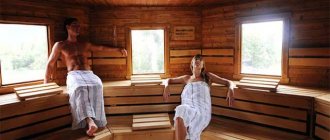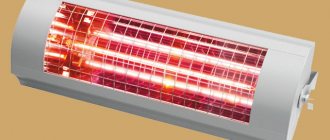The sauna is an amazing stress reliever
It is also important, especially in the current living conditions, that the sauna and Russian bath are excellent sedatives. They will become real antidepressants for the frayed nervous system of modern man. Scientists have found that with regular trips to the sauna, the speed of the body's reactions improves, and balance and coordination of movements are restored.
But in order for the sauna to benefit you and improve rather than ruin your mood, when visiting it you must comply with several requirements.
A real Russian bath: the secret of light steam
The steam cake is a thick, up to 50 cm, layer of strong superheated steam that hangs above the shelf above the shelf when the water thrown on the heater evaporates. Experienced steamers skillfully work with the cake, scoop up steam from it with a broom and distribute it over the body of the person being steamed so as to steam the body, but not burn it. Not all bathhouse adherents agree to consider the cake to be of some special value, arguing that conditioned steam, which evenly fills the entire volume of the steam room from floor to ceiling, is more comfortable and healthy. Often, steam room lovers come to the combination of a pleasant, relaxing conditioning regime with hot steam from the cake to steam certain areas of the body. An interesting effect from using mixed modes is achieved when a person first warms up in conditioned steam, and then steams, adding steam from the cake.
The characteristics of the Russian steam room also determine its size; they are "attached" to the steam. In order for the layer of steam to be sufficiently stable, it needs space under the ceiling, but so that the steamer can freely scoop up the steam with a broom. Therefore, the optimal height of the steam room is 2.5 meters, the shelves are made higher and a step is attached to it. The size of the steam room is usually 2.5x2.5 m, for a family steam room from 3x3 to 5x5 m. This is also related to the steam - it should be enough for a full steaming session, but it should not be wasted in a too large room. The door to the steam room is always small (height from the floor 1.8 meters, width 60 cm) and this is again because of the steam, it is impossible for it to leak out of the steam room; the threshold is high (25–30 centimeters) - so that colder air does not creep into the room and does not create unacceptable drafts. Felt is stuffed around the perimeter of the door to prevent steam from escaping into the cracks. The window was traditionally located low, the lower edge was a meter from the floor, and was made small. The ceiling of the steam room was always well insulated.
The cozy steam room, decorated with wood, is in itself an excellent place for relaxation. And brooms, fragrant decoctions, dry grass on the shelf, birch firewood, decoctions and infusions expand the range of effects of steam on the body, give strength and make the Russian bathhouse the undisputed leader among all the bathhouses in the world. The steam is ours!
And sometimes everything in the bathhouse contradicts the signs described above, and it looks super modern and innovative, but it brings no less pleasure than an authentic log house with a brick stove - read the story about this in the article on FORUMHOUSE. Find out how to properly prepare brooms. Read the story about a man who was able to improve his steam room nine times! Watch a video about what a real Russian steam room should be like.
Subscribe to our Telegram channelExclusive posts every week
Infrared sauna
There are several types of saunas. For example, an Infrared sauna is a thermal treatment device in which a seated person is heated using infrared radiation rather than air. The heating method is the main difference between infrared saunas and other types of baths and saunas. A session in such a sauna usually lasts 30 minutes at an air temperature of only 37-47°C and natural humidity. Sweating in an infrared sauna is significantly higher than in conventional saunas and baths, under much milder conditions, which achieves a greater healing effect in relation to other saunas.
Heaters must produce such a flow of infrared energy that this energy can penetrate deep into the human body, and not just heat the upper layers of the skin. It is the radiation power of the heaters that distinguishes infrared cabins from other types of baths. The operating temperature of the heater surface must be at least 230-280°C; only at these temperatures can the required level of IR energy be achieved. Cabins containing low temperature heaters cannot be considered “infrared”. Because these heaters produce too little IR energy.
Temperature and humidity
Before starting a session in the infrared sauna, it is necessary to prepare it, i.e. create a certain microclimate. The air temperature inside the sauna before the start of the session should be at least 35-37°C, and the humidity no more than 45-50%. A person who is inside the cabin receives energy from the heaters, the internal body temperature rises and the thermal regulation system, trying to compensate for this temperature increase, begins the process of sweating. The air humidity inside the cabin is: at the beginning of the session 40% and rises to 60% by the end of the session.
The air temperature in an infrared sauna is not critical for hyperthermic procedures - a person is heated not with the help of hot air, but with the help of direct infrared radiation from the heaters. However, for a normal sweating session, the air temperature in the cabin must be above 35°C, because At lower air temperatures, the human body will cool down. At temperatures above 50°C, difficult conditions will be created for human well-being.
Cabin size
The minimum dimensions of the cabin are determined by the dimensions of the seated person. A sitting person of average height occupies an area of 60x70 cm. To comfortably accommodate a person, an area of at least 80x80 cm is required; in a smaller volume, the person will be cramped, and in some cases there will be a fear of confined spaces. Taking into account that the thickness of the cabin walls is 15 cm, we recommend making cabins with external dimensions of at least 95x95 cm.
Heaters
Heaters are installed on all sides of a person in order to cover the human body with infrared radiation as completely as possible, but their number cannot be increased, because this leads to an increase in the air temperature in the cabin:
- Corner (front) heaters are installed on the cabin floor in a vertical position to warm the shins and feet. Installing corner heaters at chest level leads to a decrease in heating efficiency, because in this case, the distance to the body increases beyond the norm. The foot heater is installed under the bench and serves to warm up the calf muscles.
- Rear heaters are installed behind a seated person. During the session, to warm up other parts of the body, you can turn sideways towards the heaters. Typically, five heaters are sufficient for a single cabin, and six for a double cabin.
Stages of sweating
There are 4 stages of sweating during a session in an infrared sauna:
- The first stage is energy accumulation, where internal energy is accumulated. At this stage, sweating is not significant. Duration – 7-10 minutes.
- The second stage is profuse sweating, in which the largest release of sweat is produced due to the removal of water from the subcutaneous space. Duration – 10-12 minutes.
- At the third stage, sweating decreases, because Almost all unbound water has already been removed from the body and the increase in internal body temperature accelerates. Duration – 7-10 minutes.
- The fourth stage begins after the end of the session and is characterized by a slight increase in sweating due to the energy accumulated by the body. Duration – 5-8 minutes.
Everything described above does not apply to panel cabins - you cannot warm up deeply and thoroughly in them.
The fourth difference is building materials
When building a sauna, not only wood is used, but also modern synthetic materials. A real Russian bathhouse cannot even imagine synthetics in its decoration. From time immemorial, the bathhouse was insulated with moss and caulked with felt...
Of course, progress has reached Russian lands, and now we also use synthetic materials when designing and building bathhouses. We insulate, insulate, and so on. But such newfangled baths can hardly be called real Russian; they are rather a hybrid of a bathhouse and a sauna. However, this is my personal opinion...











